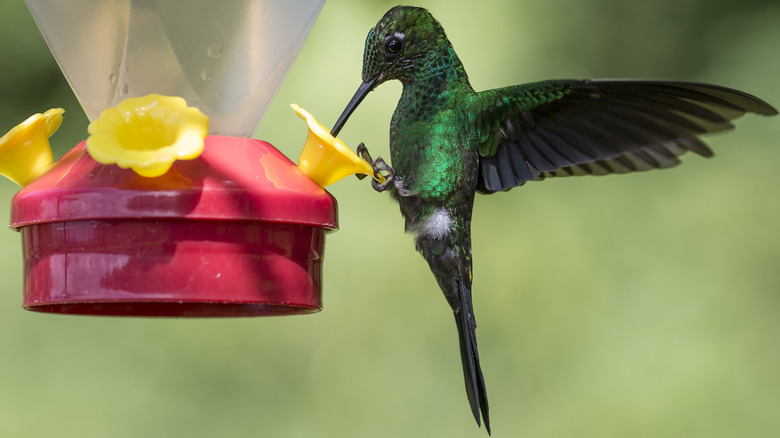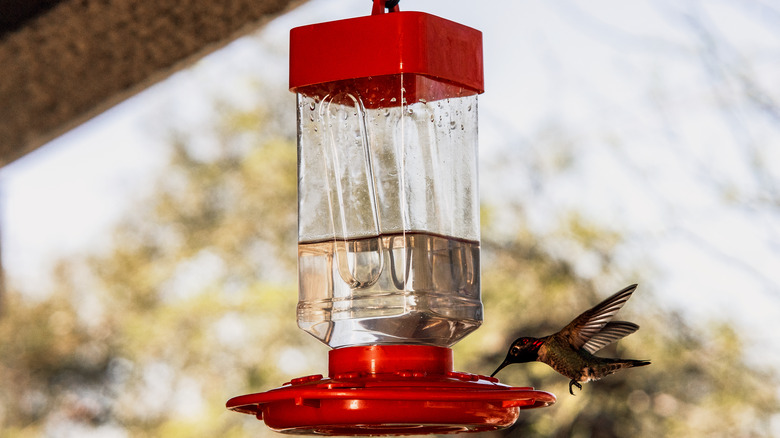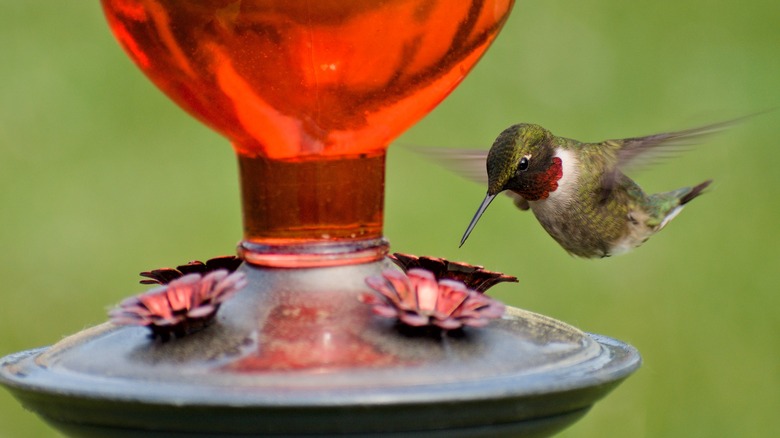Errors You Don't Want To Make With Your Hummingbird Feeder
They are tiny yet powerful flying puffballs sporting iridescent feathers and a needle-like beak that become a colorful blur during their daily aerial acrobatic show. It's no wonder homeowners throughout the western hemisphere eagerly install hummingbird feeders in their yards. Who wouldn't want to be treated to an avian-style Cirque du Soleil performance while sipping their morning coffee? Still, satiating hungry hummingbirds with a hanging feeder is not as simple as you may think. To avoid causing irreparable harm to hummers, avoid making common errors regarding the feeder's placement, maintenance, and food source.
No one puts up a hummingbird feeder thinking it will do more harm than good. However, small mistakes can snowball into big problems for hummingbirds if you are not careful. Consequently, it's a good idea to proceed with caution when inviting them to dine in your backyard. In the case of hummingbirds, looks can be deceiving. The stunning winged dynamos are strong enough to endure g-forces that would melt some of the best fighter jet pilots. Meanwhile, their agility — they can fly forward, backward, upside down, and hover — rivals the most technologically advanced drones. Still, hummingbirds are not invincible. To ensure their health and well-being it's important to consider a few safeguards before adding a hummingbird feeder to your property.
Don't overlook location and maintenance
While it's tempting to install a hummingbird feeder near a window or in an open area to score unobstructed views of hummers pulling off mind-bending moves, resist the urge. Hummingbirds prefer quiet to chaos. An ideal location for a hummingbird feeder is near shelter (roughly 10 to 15 feet from shade), yet not completely shielded by cover. Feeders need to be visible to hummers; however, they shouldn't be installed in completely exposed spaces that are susceptible to high winds and strong storms. Also, look out for branches. Don't place a hummingbird feeder around tree limbs that are strong enough to hold predators. Cats are notorious for using branches to lie in wait for unsuspecting hummingbirds, while squirrels and chipmunks target baby hummers and unhatched eggs.
Once you find the perfect spot to hang your hummingbird feeder don't neglect it. Homeowners frequently make the mistake of simply refilling feeders rather than learning how to properly clean them. If you want to make your backyard a welcome habitat for hummingbirds instead of a breeding ground for bacteria and disease, it's vital to maintain feeders. Schedule weekly cleanings to eliminate algae, mold, and germs that may grow due to contaminated bird droppings or rotten food. Simply empty the feeder then scrub it with hot soapy water or a diluted bleach solution. To remove debris from crevices, use a straw cleaning brush. Otherwise, if the care instructions permit, simply run the feeder in the dishwasher.
Don't alter hummingbirds' diet
Nothing fuels hummingbirds like their favorite sweet treat: nectar. Homemade hummingbird nectar is surprisingly easy to make; however, if you make an error with the recipe you could jeopardize the health of your favorite fluttering friend. Fill your hummingbird feeder with nectar made of 1 part white sugar and 4 parts water. That's it. Don't try to get fancy by adding honey, brown sugar, powdered sugar, or fruit juice. Honey's sticky consistency is especially dangerous to hummingbirds as it can act like a glue if it gets caught on their tongues and potentially weld their bills shut. Likewise, honey gums up feeders and attracts insects that can cause harm to hummingbirds. Honey also has a high level of natural sugar causing it to rapidly ferment alcohol. If a hummingbird consumes this toxic liquid, it could become sick or die. The same applies to brown sugar which contains elevated levels of iron. Ingesting high quantities of iron is also detrimental to hummingbirds.
Finally, don't fall for the red-colored sugar water trap. You may have heard how much hummingbirds are attracted to the color red or perhaps you've seen bottled red sugar water on store shelves; leave it there. Red dye is not a hummingbird magnet. In fact, the artificial ingredients in red food coloring can hurt hummingbirds by promoting the growth of tumors on their bills and liver. A safer option is to purchase an all-red hummingbird feeder or one that has red accents.


